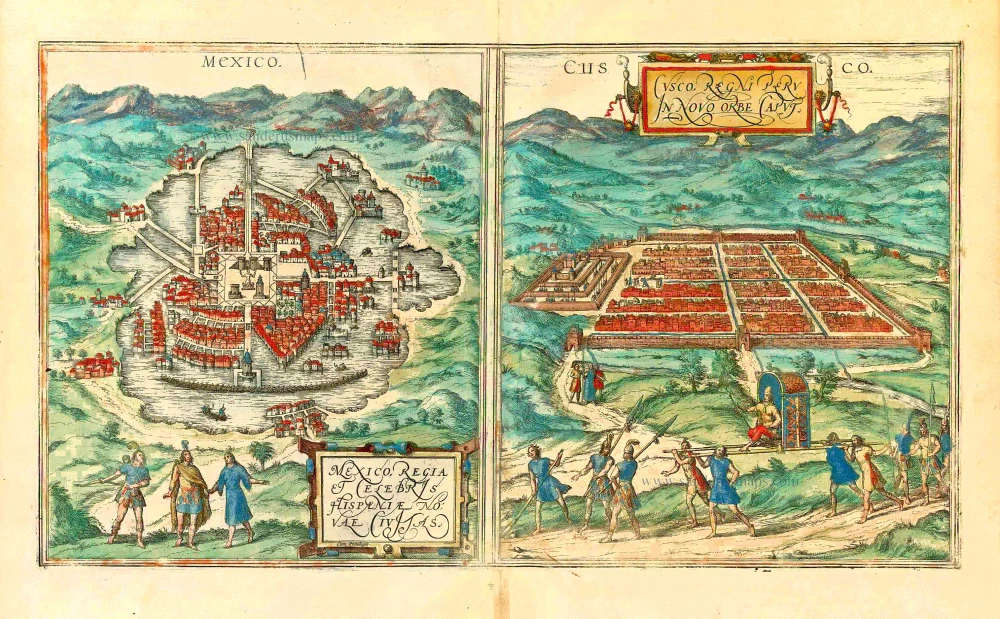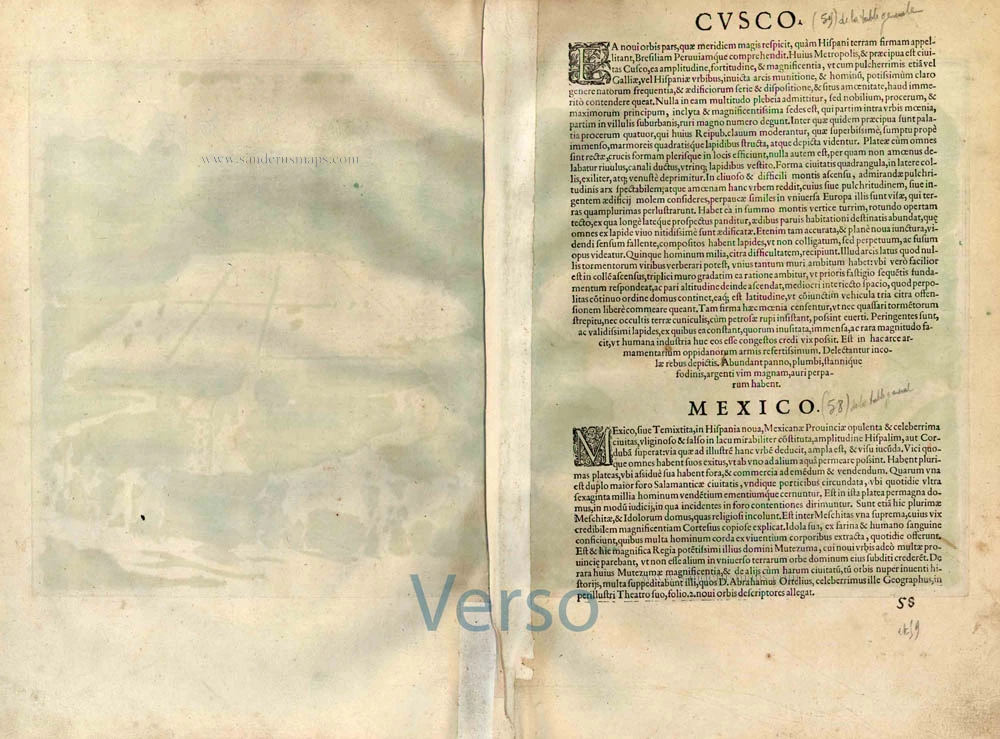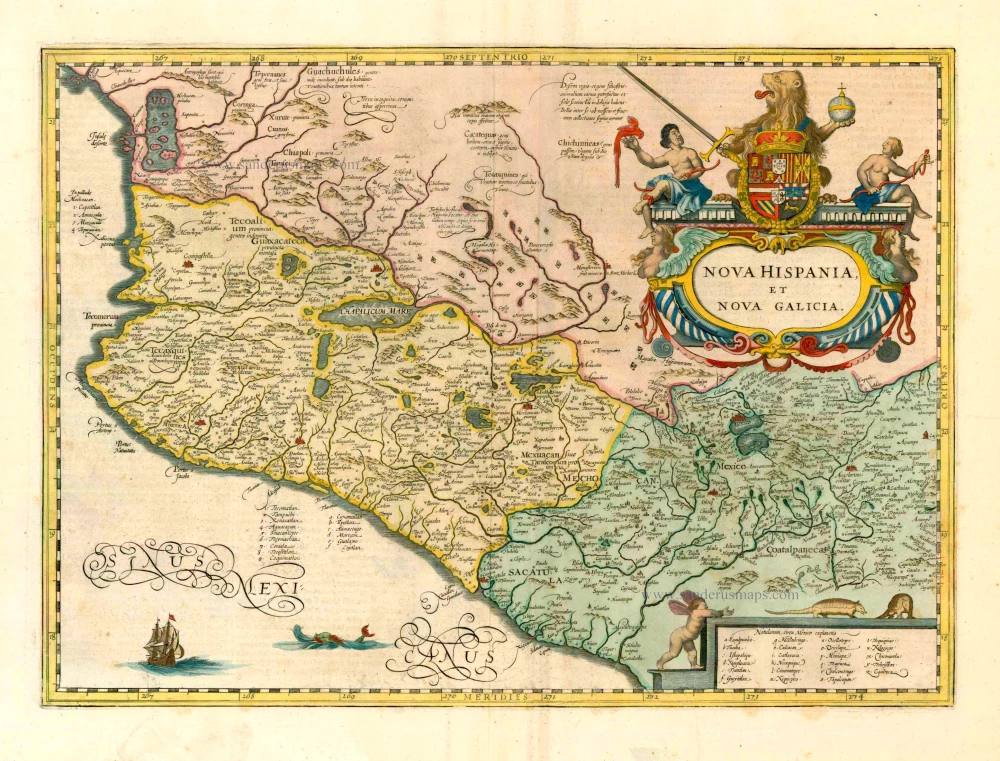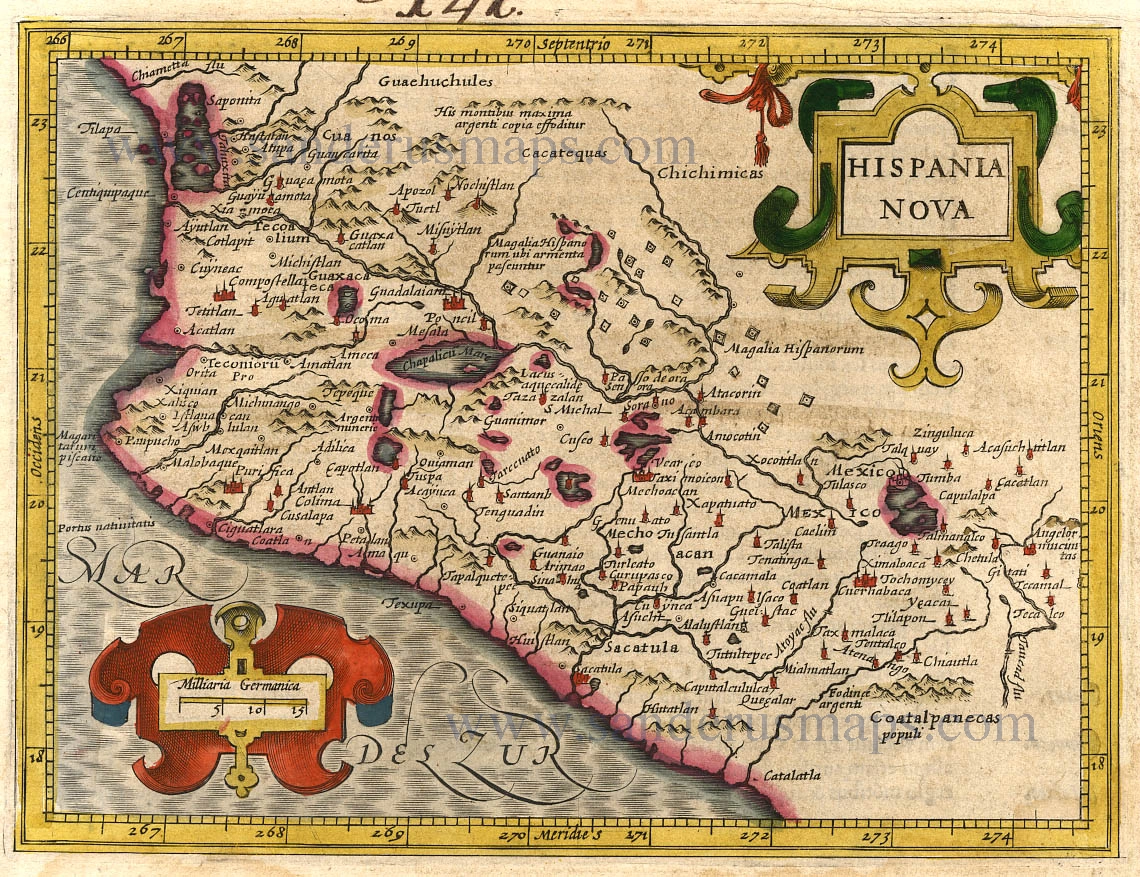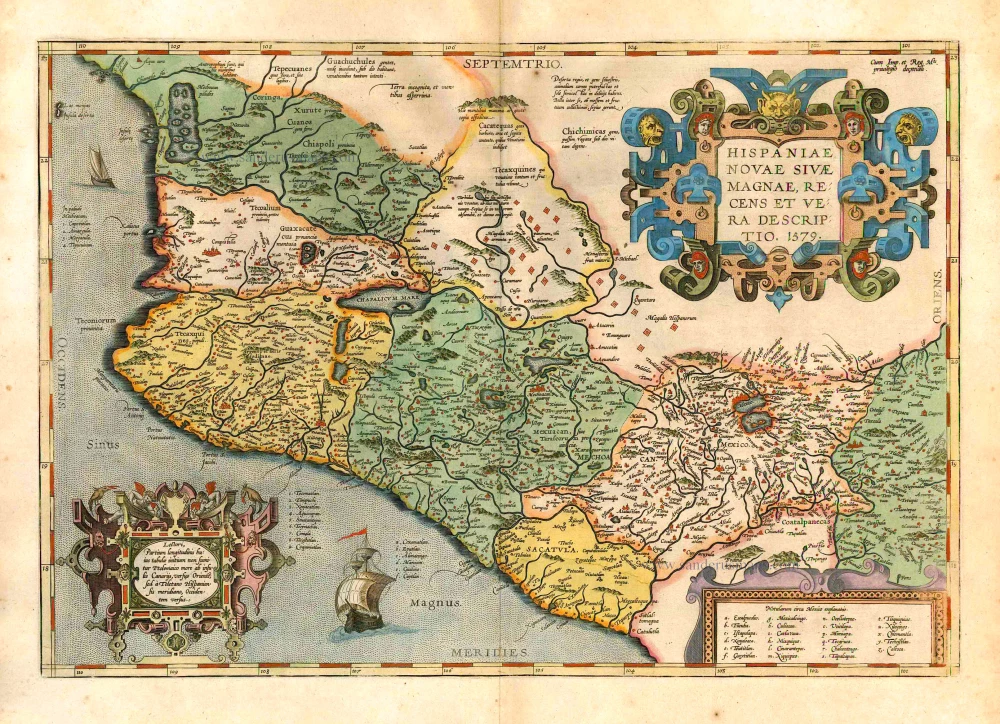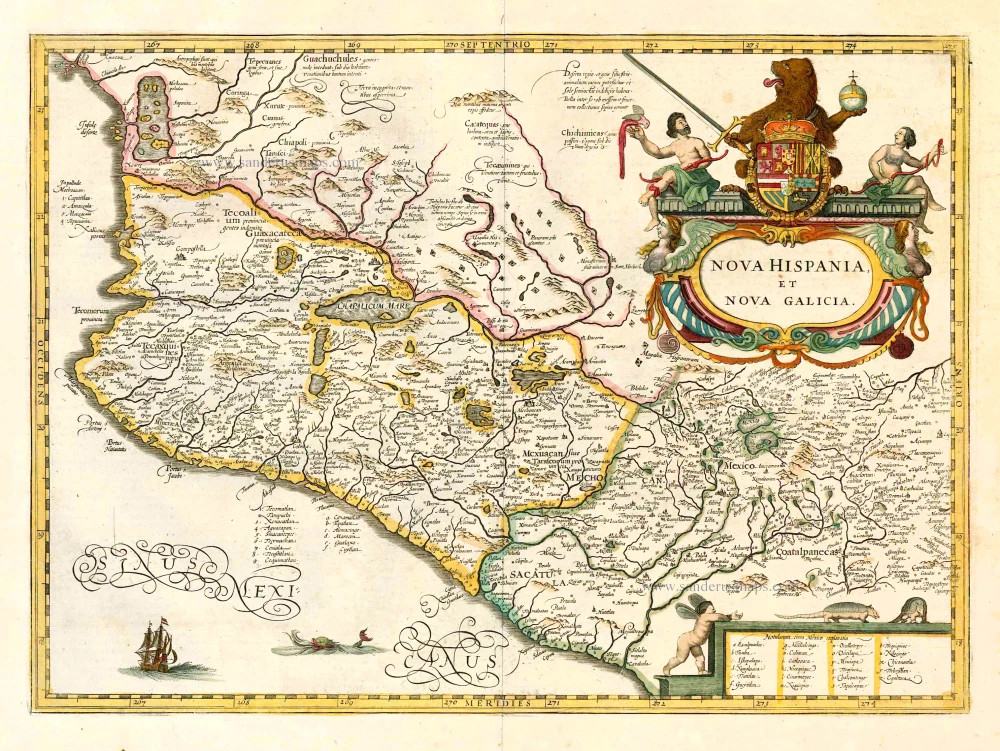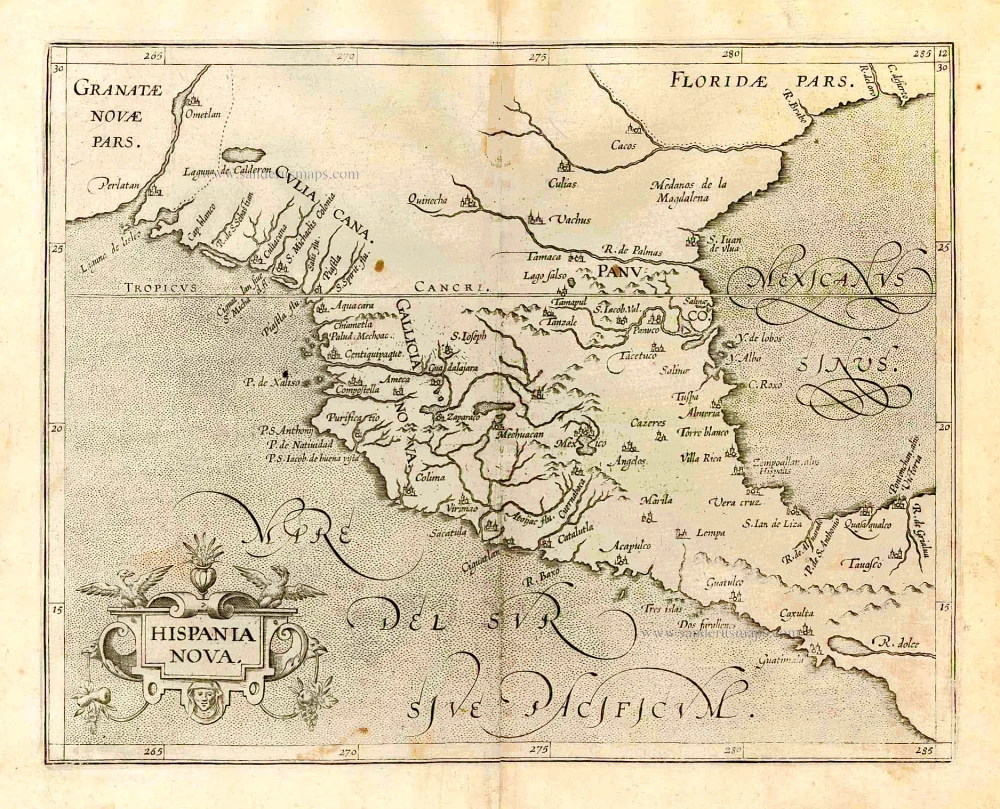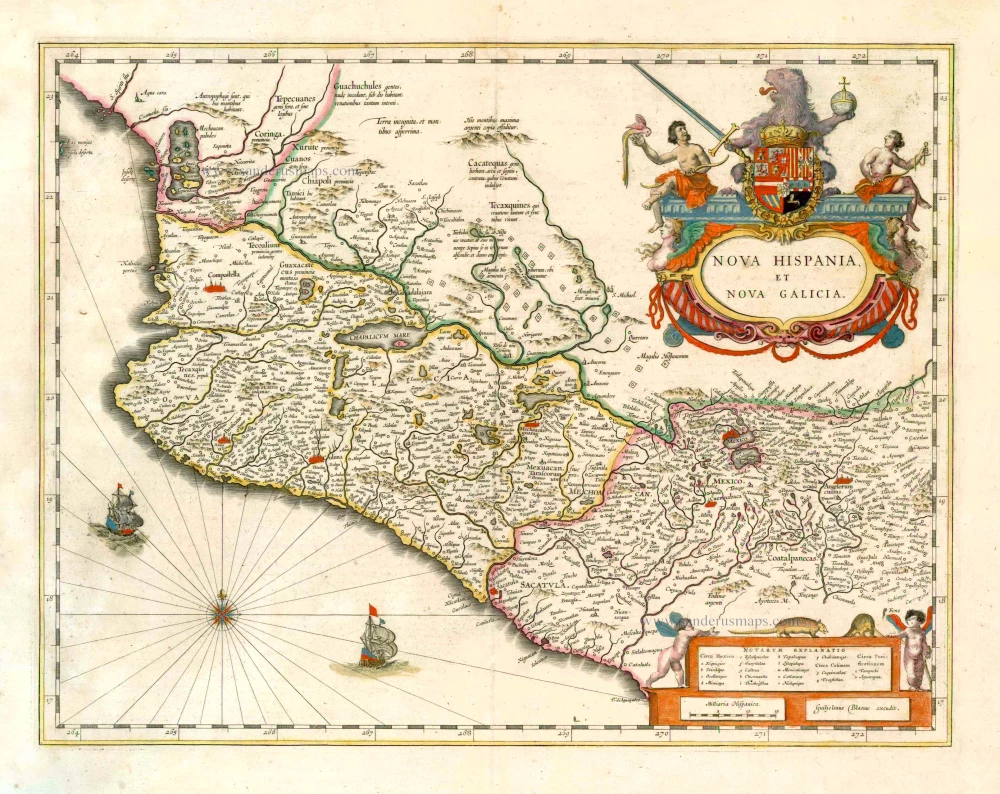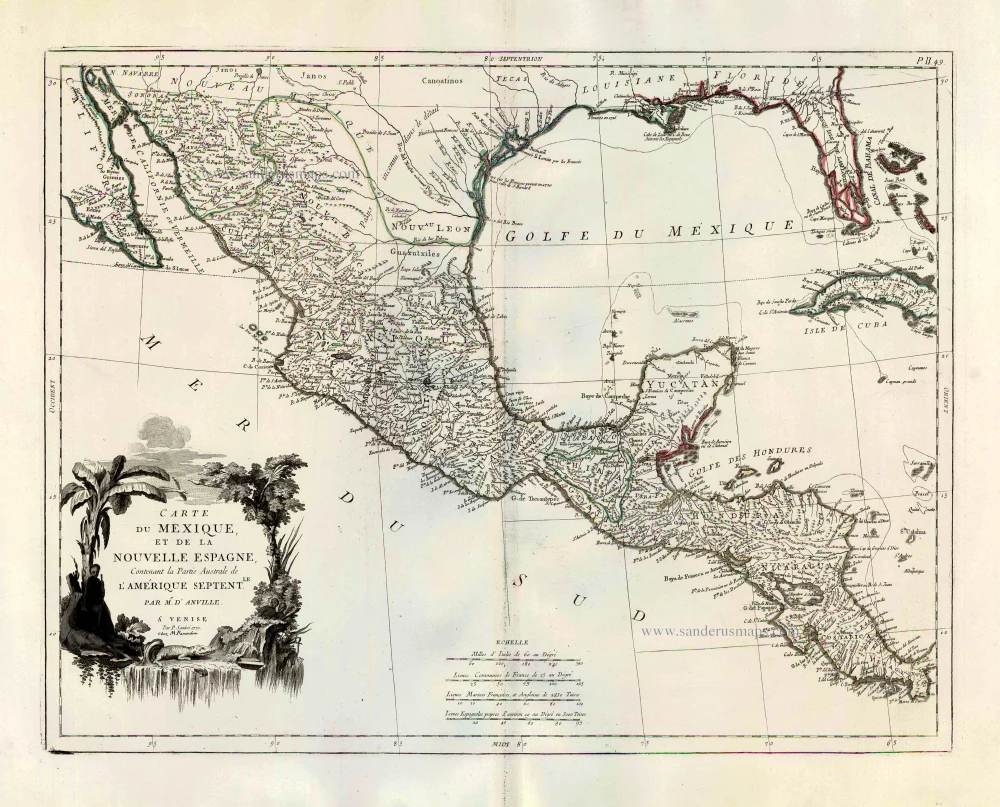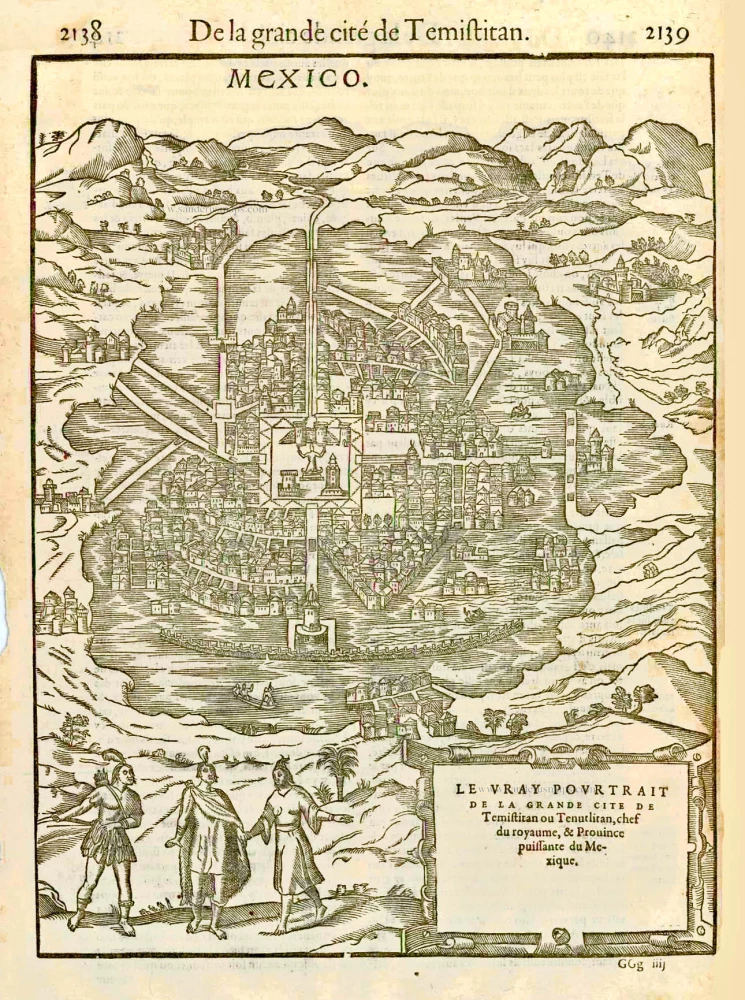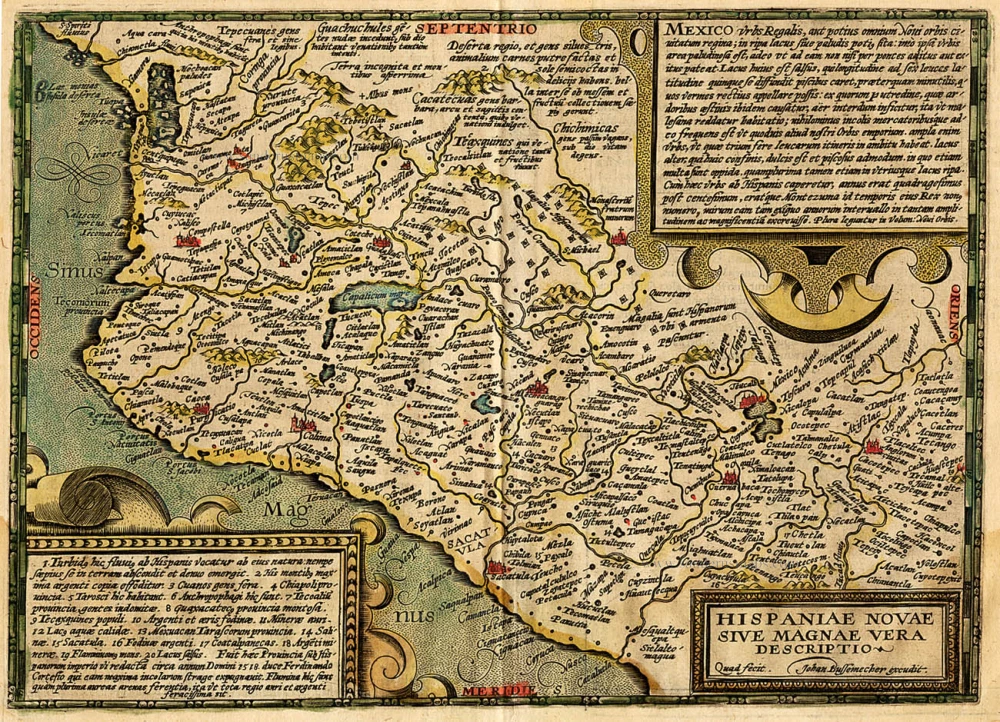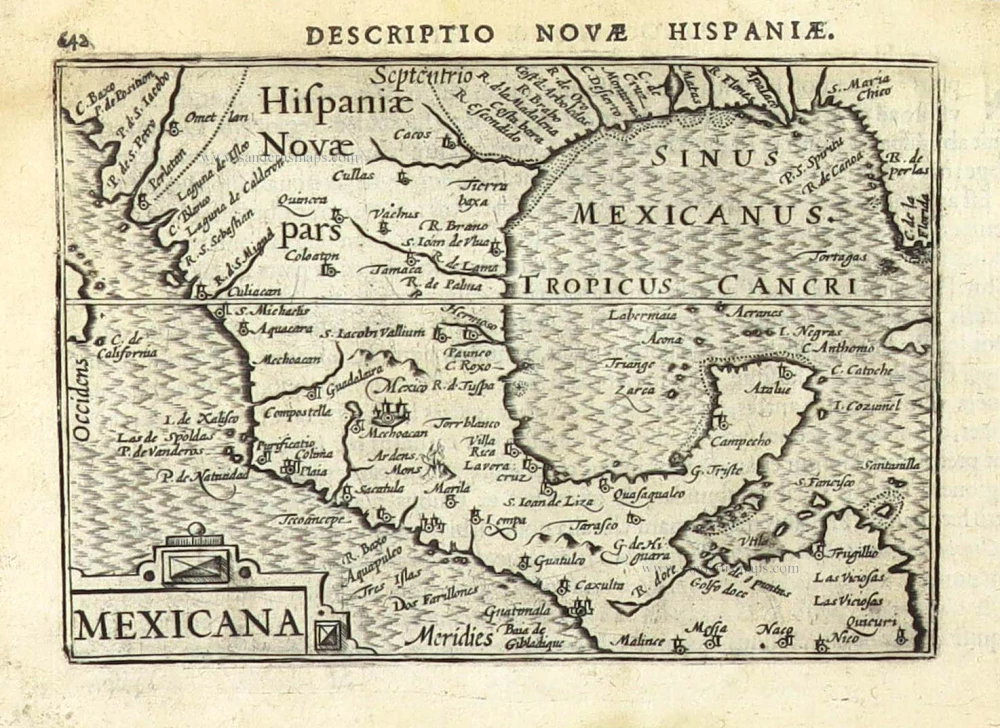Mexico and Cusco by Georg Braun and Frans Hogenberg. 1582
MEXICO
Translation of cartouche text: Mexico, the royal and famous city of New Spain.
COMMENTARY BY BRAUN: "Mexico, or Tenochtitlan, is a rich and important city in New Spain in the Mexican provinces, lying in a saltwater lake. There are many heathen temples here, which their priests live in; the most important amongst them is a temple whose quite incredible magnificence is described in detail by Hernan Cortés. They make their heathen images out of flour and human blood, and every day sacrifie a large number of human hearts to them, which they cut out of the living bodies. A magnificent palace belonging to the most powerful lord, Moctezuma, also stands here."
Tenochtitlan was founded around 1325 on an island in Lake Texcoco by wandering Aztec tribes. As the number of inhabitants grew to over 100,000 over the next 200 years, the city spread across ever more of the lake's islets, which were linked by dams and bridges and drained by canals. The plate shows the magnificent central square with the palace of Moctezuma II and the Templo Mayor dedicated to the god Huitzilopochtli, where human sacrifice was performed. Reports of cannibalism and human sacrifice are a recurring theme of contemporary European accounts and were used to justify the Spanish conquest. Although the Aztecs were able to hold off Cortés and his troops in 1519, Tenochtitlan was taken by the Spanish in 1520 and the Aztec rulers were put to death. The temple and the city were extensively damaged, and a church and a palace for the viceroy of New Spain were built on the central square. The new city was called Mexico City, one of the names for the Aztecs.
CUSCO (CUZCO)
Cartouche: Cusco, capital of the Kingdom of Peru in the New Wold.
Commentary by Braun: "The capital of Peru in the south of the New World is Cusco, a city so large, powerful and beautiful that it can easily rank alongside the most important cities in Spain and France [...] The streets are generally very straight with numerous crossroads and a stream flowing down most streets. The city is particularly embellished by a wonderful palace that lies on a steep hill and has no compare in Europe." The engraving offers a steep bird's-eye view of Cusco. Its straight roads are clearly visible, although the blocks of houses are slightly too small and are drawn in a distorted perspective. According to legend, Cusco was founded around 1200 by Manco Capac, the Quechua Indian who became the first Inca: the Quechua name for the city is Qusqu, meaning "navel of the world". On 15 November 1533 Cusco was conquered by the Spanish under the command of Francisco Pizarro, who tried to manipulate the Inca rulers to his own ends. The latter broke their alliance with the Spanish in 1536 and the ensuing Inca uprising lasted until 1572. (Taschen)
Braun G. & Hogenberg F. and the Civitates Orbis Terrarum.
The Civitates Orbis Terrarum, or the "Braun & Hogenberg", is a six-volume town atlas and the most excellent book of town views and plans ever published: 363 engravings, sometimes beautifully coloured. It was one of the best-selling works in the last quarter of the 16th century. Georg Braun wrote the text accompanying the plans and views on the verso. Many plates were engraved after the original drawings of a professional artist, a professional artist, Joris Hoefnagel (1542-1600). The first volume was published in Latin in 1572, and the sixth in 1617. Frans Hogenberg created the tables for volumes I through IV, and Simon van den Neuwel made those for volumes V and VI. Other contributors were cartographers Daniel Freese and Heinrich Rantzau. Works by Jacob van Deventer, Sebastian Münster, and Johannes Stumpf were also used. Translations appeared in German and French.
Following the original publication of Volume 1 of the Civitates in 1572, seven further editions of 1575, 1577, 1582, 1588, 1593, 1599 and 1612 can be identified. Vol.2, first issued in 1575, was followed by further editions in 1597 and 1612. The subsequent volumes appeared in 1581, 1588, 1593, 1599 and 1606. The German translation of the first volume appeared from 1574 on, and the French edition from 1575 on.
Several printers were involved: Theodor Graminaeus, Heinrich von Aich, Gottfried von Kempen, Johannis Sinniger, Bertram Buchholtz and Peter von Brachel, who all worked in Cologne.
Georg Braun (1541-1622)
Georg Braun was born in Cologne in 1541. After his studies in Cologne, he entered the Jesuit Order as a novice. 1561, he obtained his bachelor's degree, and in 1562, he received his Magister Artium. Although he left the Jesuit Order, he studied theology, gaining a licentiate in theology.
Frans Hogenberg (1535-1590)
Frans Hogenberg was a Flemish and German painter, engraver, and mapmaker. He was born in Mechelen as the son of Nicolaas Hogenberg.
By the end of the 1560s, Frans Hogenberg was employed upon Abraham Ortelius's Theatrum Orbis Terrarum, published in 1570; he is named an engraver of numerous maps. In 1568, he was banned from Antwerp by the Duke of Alva and travelled to London, where he stayed a few years before emigrating to Cologne. He immediately embarked on his two most important works, the Civitates, published in 1572 and the Geschichtsblätter, which appeared in several series from 1569 until about 1587.
Thanks to large-scale projects like the Geschichtsblätter and the Civitates, Hogenberg's social circumstances improved with each passing year. He died as a wealthy man in Cologne in 1590.
Mexico, Regia et Celebris Hispaniae Novae Civitas ... [on sheet with] Cusco, Regni Peru in Novo Orbe Caput
Item Number: 27465 Authenticity Guarantee
Category: Antique maps > America > South America
Old, antique bird’s-eye view plan of Mexico and Cusco by Georg Braun and Frans Hogenberg.
Title: Mexico, Regia et Celebris Hispaniae Novae Civitas ... [on sheet with] Cusco, Regni Peru in Novo Orbe Caput
Date of the first edition: 1572.
Date of this map: 1582.
Copper engraving, printed on paper.
Size (not including margins): 270 x 480mm (10.63 x 18.9 inches).
Verso: Latin text.
Condition: Original coloured, old reinforcement of tear in the lower margin.
Condition Rating: A.
From: Civitates Orbis Terrarum, Liber Primus. Köln, Gottfried von Kempen, 1582. (Van der Krogt 4, 41:1.1(1582))
From about 1579, there is a crack in the copperplate which is visible in the engraving to the right of the title Mexico.
MEXICO
Translation of cartouche text: Mexico, the royal and famous city of New Spain.
COMMENTARY BY BRAUN: "Mexico, or Tenochtitlan, is a rich and important city in New Spain in the Mexican provinces, lying in a saltwater lake. There are many heathen temples here, which their priests live in; the most important amongst them is a temple whose quite incredible magnificence is described in detail by Hernan Cortés. They make their heathen images out of flour and human blood, and every day sacrifie a large number of human hearts to them, which they cut out of the living bodies. A magnificent palace belonging to the most powerful lord, Moctezuma, also stands here."
Tenochtitlan was founded around 1325 on an island in Lake Texcoco by wandering Aztec tribes. As the number of inhabitants grew to over 100,000 over the next 200 years, the city spread across ever more of the lake's islets, which were linked by dams and bridges and drained by canals. The plate shows the magnificent central square with the palace of Moctezuma II and the Templo Mayor dedicated to the god Huitzilopochtli, where human sacrifice was performed. Reports of cannibalism and human sacrifice are a recurring theme of contemporary European accounts and were used to justify the Spanish conquest. Although the Aztecs were able to hold off Cortés and his troops in 1519, Tenochtitlan was taken by the Spanish in 1520 and the Aztec rulers were put to death. The temple and the city were extensively damaged, and a church and a palace for the viceroy of New Spain were built on the central square. The new city was called Mexico City, one of the names for the Aztecs.
CUSCO (CUZCO)
Cartouche: Cusco, capital of the Kingdom of Peru in the New Wold.
Commentary by Braun: "The capital of Peru in the south of the New World is Cusco, a city so large, powerful and beautiful that it can easily rank alongside the most important cities in Spain and France [...] The streets are generally very straight with numerous crossroads and a stream flowing down most streets. The city is particularly embellished by a wonderful palace that lies on a steep hill and has no compare in Europe." The engraving offers a steep bird's-eye view of Cusco. Its straight roads are clearly visible, although the blocks of houses are slightly too small and are drawn in a distorted perspective. According to legend, Cusco was founded around 1200 by Manco Capac, the Quechua Indian who became the first Inca: the Quechua name for the city is Qusqu, meaning "navel of the world". On 15 November 1533 Cusco was conquered by the Spanish under the command of Francisco Pizarro, who tried to manipulate the Inca rulers to his own ends. The latter broke their alliance with the Spanish in 1536 and the ensuing Inca uprising lasted until 1572. (Taschen)
Braun G. & Hogenberg F. and the Civitates Orbis Terrarum.
The Civitates Orbis Terrarum, or the "Braun & Hogenberg", is a six-volume town atlas and the most excellent book of town views and plans ever published: 363 engravings, sometimes beautifully coloured. It was one of the best-selling works in the last quarter of the 16th century. Georg Braun wrote the text accompanying the plans and views on the verso. Many plates were engraved after the original drawings of a professional artist, a professional artist, Joris Hoefnagel (1542-1600). The first volume was published in Latin in 1572, and the sixth in 1617. Frans Hogenberg created the tables for volumes I through IV, and Simon van den Neuwel made those for volumes V and VI. Other contributors were cartographers Daniel Freese and Heinrich Rantzau. Works by Jacob van Deventer, Sebastian Münster, and Johannes Stumpf were also used. Translations appeared in German and French.
Following the original publication of Volume 1 of the Civitates in 1572, seven further editions of 1575, 1577, 1582, 1588, 1593, 1599 and 1612 can be identified. Vol.2, first issued in 1575, was followed by further editions in 1597 and 1612. The subsequent volumes appeared in 1581, 1588, 1593, 1599 and 1606. The German translation of the first volume appeared from 1574 on, and the French edition from 1575 on.
Several printers were involved: Theodor Graminaeus, Heinrich von Aich, Gottfried von Kempen, Johannis Sinniger, Bertram Buchholtz and Peter von Brachel, who all worked in Cologne.
Georg Braun (1541-1622)
Georg Braun was born in Cologne in 1541. After his studies in Cologne, he entered the Jesuit Order as a novice. 1561, he obtained his bachelor's degree, and in 1562, he received his Magister Artium. Although he left the Jesuit Order, he studied theology, gaining a licentiate in theology.
Frans Hogenberg (1535-1590)
Frans Hogenberg was a Flemish and German painter, engraver, and mapmaker. He was born in Mechelen as the son of Nicolaas Hogenberg.
By the end of the 1560s, Frans Hogenberg was employed upon Abraham Ortelius's Theatrum Orbis Terrarum, published in 1570; he is named an engraver of numerous maps. In 1568, he was banned from Antwerp by the Duke of Alva and travelled to London, where he stayed a few years before emigrating to Cologne. He immediately embarked on his two most important works, the Civitates, published in 1572 and the Geschichtsblätter, which appeared in several series from 1569 until about 1587.
Thanks to large-scale projects like the Geschichtsblätter and the Civitates, Hogenberg's social circumstances improved with each passing year. He died as a wealthy man in Cologne in 1590.

